SEDE VACANTE 2013
February 28, 2013—March 13, 2013
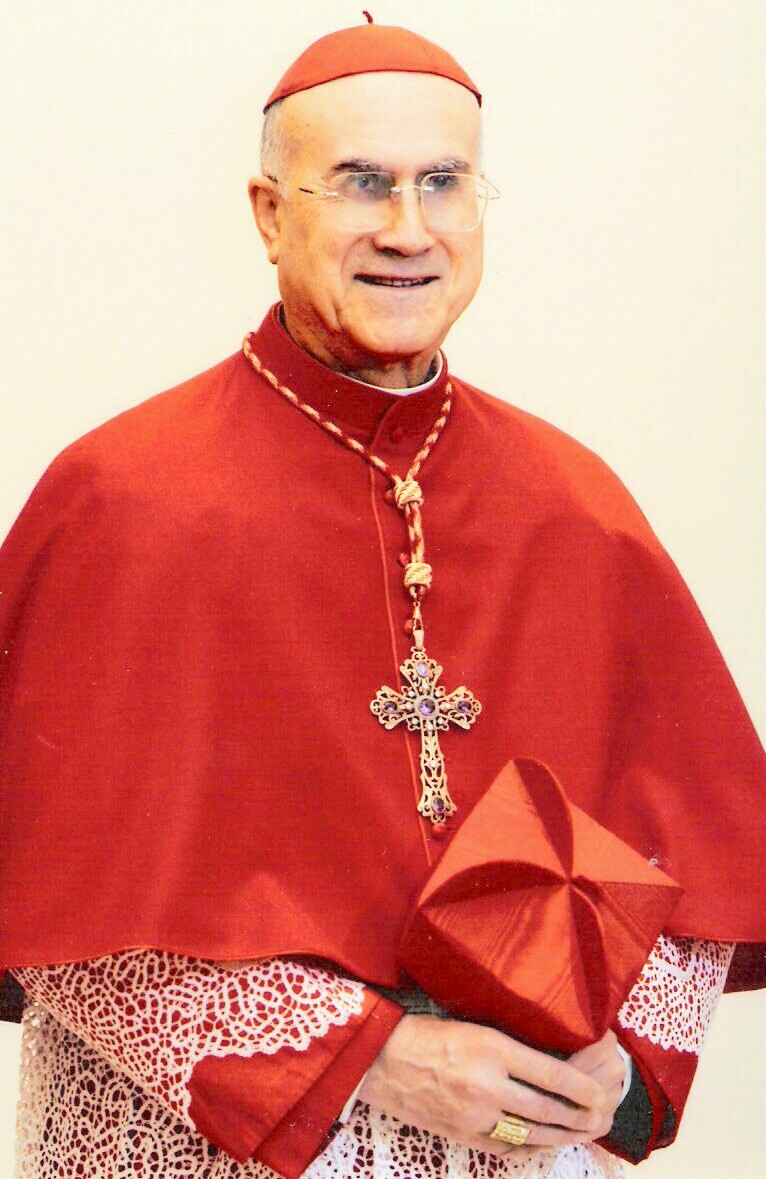 TARCISIO BERTONE, SDB, Cardinal-Bishop of Frascati and Chamberlain of the Holy Roman Church, was born in the Piedmont, at Romano Canavese, on December 2, 1934. He claims that his mother was an anti-Fascist during the regime of Mussolini. He became a professed member of the Salesian Priests on December 3, 1950. He obtained a degree of Doctor of Canon Law (Juris Canonici Doctor), based on a study of the administration of Benedict XIV, in which it is demonstrated that Benedict XIV did everything correctly and prudently (His director, Relator, was Alfons Cardinal Stickler, a fellow member of the Salesians). He taught Moral Theology (not his academic specialty) in his order's Roman seminary from 1967-1976, and was promoted to the teaching of Canon Law (his academic specialty) from 1976-1991. He worked as part of the team that was carrying out the final revision of the 1983 Code of Canon Law, and was one of the emissaries sent by Rome to each of the Italian dioceses to introduce the Italian text of the Code. His appointment as Professor brought with it the title of "Dean of the Faculty of Canon Law". In 1985 he became Vice-Rector of the Salesian University, a post he held from 1987-1989. He was also a Consultor (advisor) in several of the Dicasteries of the Roman Curia. This is normal practice, since the duties at the small Ecclesiastical Roman Academies, Institutes, and Universities are not onerous or excessively time-consuming. It is the normal way for clerics with prospects to make the contacts necessary to ensure the promotion of their careers.
TARCISIO BERTONE, SDB, Cardinal-Bishop of Frascati and Chamberlain of the Holy Roman Church, was born in the Piedmont, at Romano Canavese, on December 2, 1934. He claims that his mother was an anti-Fascist during the regime of Mussolini. He became a professed member of the Salesian Priests on December 3, 1950. He obtained a degree of Doctor of Canon Law (Juris Canonici Doctor), based on a study of the administration of Benedict XIV, in which it is demonstrated that Benedict XIV did everything correctly and prudently (His director, Relator, was Alfons Cardinal Stickler, a fellow member of the Salesians). He taught Moral Theology (not his academic specialty) in his order's Roman seminary from 1967-1976, and was promoted to the teaching of Canon Law (his academic specialty) from 1976-1991. He worked as part of the team that was carrying out the final revision of the 1983 Code of Canon Law, and was one of the emissaries sent by Rome to each of the Italian dioceses to introduce the Italian text of the Code. His appointment as Professor brought with it the title of "Dean of the Faculty of Canon Law". In 1985 he became Vice-Rector of the Salesian University, a post he held from 1987-1989. He was also a Consultor (advisor) in several of the Dicasteries of the Roman Curia. This is normal practice, since the duties at the small Ecclesiastical Roman Academies, Institutes, and Universities are not onerous or excessively time-consuming. It is the normal way for clerics with prospects to make the contacts necessary to ensure the promotion of their careers.
At the age of 56, on the recommendation of Cardinal Bernard Gantin, the Prefect of the Congregation of Bishops, he was named by Pope John Paul II to be Archbishop of Vercelli (1991-1995), a small town in the Piedmont some 70 km. northeast of Turin. During his episcopate the number of Catholics remained approximately the same (ca. 178,000) but the number of clergy declined by nearly a fifth. In 1995 he returned to Rome as Secretary of the Congregation for the Doctrine of the Faith, under Cardinal Joseph Ratzinger (Benedict XVI), but he returned north as Archbishop of Genoa in December, 2002. He was created a cardinal Priest by John Paul II on October 21, 2003, with the titulus of S. Maria Ausiliatrice in via Tuscolana. He participated in the Conclave of April 18—April 19, 2005, in which Cardinal Joseph Ratzinger was elected Pope Benedict XVI. He returned to Rome again and became Secretary of State of His Holiness on September 15, 2006, and was soon named Camerlengo S.R.E. on April 4, 2007. The combination of those two offices is becoming a normal practice at the Vatican (as with Gasparri, Pacelli and Villot). His appointment as Secretary of State caused considerable friction in the Curia, since his credentials as a diplomat were nonexistent. Each of his gaffes (and they were not a few) was carefully collected, dissected, and passed around the civil service by his enemies. His handling of the scandals connected with the Institute for Works of Religion (IOR, the Vatican Bank) has been much criticized; the loss of access to credit card charges on the part of the Vatican City State in early 2013 was a major embarassment. In Benedict XVI's last years, the Vatican seemed to have formed into two hostile camps. On May 10, 2008 he was promoted by Pope Benedict XVI to be Cardinal Bishop of Frascati. He ceased holding the Secretariat of State on the resignation of Benedict XVI on February 28, 2013, but was reappointed by Pope Francis on March 16, 2013, donec aliter provideatur. He will reach the age of 80, and become ineligible to be a papal elector, on December 2, 2014. His "retirement" was announced on August 31, 2013, to take effect on October 15, 2013. He was succeeded as Secretary of State by Archbishop Pietro Paralin, now (as of February 22, 2014) Cardinal Parolin.
 |
AV, AG, Æ SEDE • APOSTOLICA • VACANTE • MMXIII (Engraver:) S. MACALUSO . Crossed keys, connected by tassels, the Ombrellone above. |
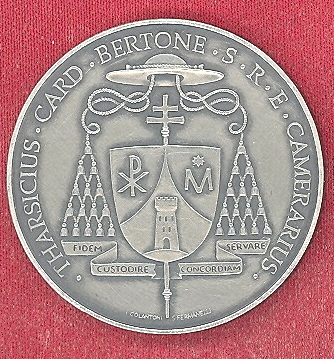 |
THARSICIUS • CARD • BERTONE• S. • R • E • CAMERARIUS (Engraver: ) I. COLANTONI | S.FERMANELLI Stemma of Cardinal Tarcisio Bertone, Camerlengo of the Holy Roman Church, upon an archiepiscopal cross, surmounted by the Cardinal's Hat with fifteen tassels on each side. His Motto: FIDEM CUSTODIRE / CONCORDIAM SERVARE ("to protect the Faith, to preserve harmony") |
3000 silver specimens and 6000 bronze specimens were issued; each is numbered on the rim
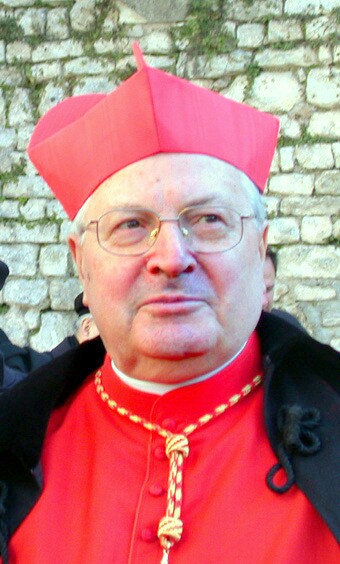 ANGELO SODANO was born in Isola d'Asti (Piedmont) on November 23, 1927. He completed his basic studies in Asti and was ordained priest by the Bishop of Asti on September 23, 1950. By that time, the Italian Republic had been born, and Sodano's father was a deputy for the Christian Democratic Party in Parliament (1948-1963). After some nine years of work in his diocese, he was sent for advanced work in Rome (1960-1968), at the Gregorian University (from which he obtained a doctorate in Theology) and at the Lateran University (from which he obtained a doctorate in Canon Law). He was appointed to the Papal diplomatic corps, and was sent as a secretary to the Nunciature of Equador, Uruguay and Chile. He was promoted to the rank of Privy Chamberlain Supernumerary in 1962 and a year later to Papal Chaplain (Monsignor). In 1968 he returned to Rome as a functionary in the Council for the Public Affairs of the Church (1968-1977). In 1977 he was appointed Apostolic Nuncio to Chile (to May 23, 1988), which required that he be made an archbishop; he was appointed Archbishop of Nova Caesaris in Numidia (Algeria), in partibus infidelium (a titular see, which he held until June 28, 1991). His tenure in Chile corresponded with the dictatorship of General Agosto Pinochet and the worst of his excesses, including a war with Argentina. He returned to Rome to succeed Achille Silvestrini as Secretary of the Council for the Public Affairs of the Church (Foreign Minister), which was renamed the Section for the Relations with the States in 1989 John Paul II, Pastor Bonus, June 22, 1988). He became, under Cardinal Agostino Casaroli's direction, President of the Pontifical Commission for Russia—which indicates that his promotion was due to the personal interest of John Paul II and his likely usefulness to Cardinal Casaroli's Ostpolitik. Sodano was promoted, on the occasion of the retirement of Cardinal Casaroli, to the post of Pro-Secretary of State on December 1, 1990. He was only pro-Secretary since he was not yet a cardinal
ANGELO SODANO was born in Isola d'Asti (Piedmont) on November 23, 1927. He completed his basic studies in Asti and was ordained priest by the Bishop of Asti on September 23, 1950. By that time, the Italian Republic had been born, and Sodano's father was a deputy for the Christian Democratic Party in Parliament (1948-1963). After some nine years of work in his diocese, he was sent for advanced work in Rome (1960-1968), at the Gregorian University (from which he obtained a doctorate in Theology) and at the Lateran University (from which he obtained a doctorate in Canon Law). He was appointed to the Papal diplomatic corps, and was sent as a secretary to the Nunciature of Equador, Uruguay and Chile. He was promoted to the rank of Privy Chamberlain Supernumerary in 1962 and a year later to Papal Chaplain (Monsignor). In 1968 he returned to Rome as a functionary in the Council for the Public Affairs of the Church (1968-1977). In 1977 he was appointed Apostolic Nuncio to Chile (to May 23, 1988), which required that he be made an archbishop; he was appointed Archbishop of Nova Caesaris in Numidia (Algeria), in partibus infidelium (a titular see, which he held until June 28, 1991). His tenure in Chile corresponded with the dictatorship of General Agosto Pinochet and the worst of his excesses, including a war with Argentina. He returned to Rome to succeed Achille Silvestrini as Secretary of the Council for the Public Affairs of the Church (Foreign Minister), which was renamed the Section for the Relations with the States in 1989 John Paul II, Pastor Bonus, June 22, 1988). He became, under Cardinal Agostino Casaroli's direction, President of the Pontifical Commission for Russia—which indicates that his promotion was due to the personal interest of John Paul II and his likely usefulness to Cardinal Casaroli's Ostpolitik. Sodano was promoted, on the occasion of the retirement of Cardinal Casaroli, to the post of Pro-Secretary of State on December 1, 1990. He was only pro-Secretary since he was not yet a cardinal
Sodano was created cardinal priest of S. Maria Nuova on June 28, 1991 and the next day was named Secretary of State. On January 10, 1994 he was promoted again, and became Cardinal Bishop of Albano, a position which he retained when he became Bishop of Ostia [The actual BIshop of Albano is Msgr. Marcello Semeraro]. He became Vice-Dean of the College of Cardinals on November 30, 2002. He ceased his function as Secretary of State on April 2, 2005, at the death of Pope John Paul II. He participated in the Conclave of April 18—April 19, 2005, in which Cardinal Joseph Ratzinger was elected Pope Benedict XVI. In the first and second ballots, he received four votes. The new Pope reappointed him Secretary of State. He succeeded Benedict XVI as Dean of the Sacred College of Cardinals on April 27, 2005, and became Bishop of Ostia while retaining the See of Albano as well as S. Maria Nuova.
Upon reaching the age of 75, his resignation was accepted, though he was asked to remain in office until September 15, 2006. On November 27, 2007, he ceased to be eligible to be present and vote in Conclave. But since he was not able to enter Conclave, nor was the Vice-Dean of the Sacred College, Cardinal Roger Etchegaray (who was also over 80), Cardinal Sodano's functions were assumed by the most senior Cardinal Bishop who was eligible to attend, Giovanni Battista Re, Bishop of Sabina. This was in accordance with Pope John Paul II's Universi Dominici Gregis § 9:
The General Congregations of Cardinals are to be held in the Apostolic Palace in the Vatican or, if circumstances demand it, in another place judged more suitable by the Cardinals. At these Congregations the Dean of the College presides or, should he be absent or lawfully impeded, the Subdean. If one or both of these, in accordance with No. 33 of this Constitution, no longer enjoy the right of electing the Pope, the assembly of the Cardinal electors will be presided over by the senior Cardinal elector, according to the customary order of precedence.
Giovanni Battista RE was born on January 30, 1934 at Borno, in the diocese of Brescia in Lombardy. He studied at the Collegio Lombardo in Rome, at the Gregorian University (Doctor of Canon Law) and the Ecclesiastical Academy. He was ordained in Brescia on March 3, 1957. He joined the Vatican Diplomatic Service in 1963, and was posted to Panama for four years, He became a monsignor (Chaplain of His Holiness) in 1964. His next assignment was as Secretary of the Nunciature in Iran (1967-1971). He returned to Rome and worked as secretary to Archbishop (later Cardinal) Giovanni Benelli, the Substitute Secretary of State. He was made an Archbishop and appointed to the post of Secretary of the Congregation of Bishops in 1987. In 1989 he became Substitute Secretary of State, and eventually returned to the Congregation of Bishops as its Prefect in 2000. He also was appointed President of the Pontifical Commission for Latin America. He was created Cardinal Priest of the Basilica of SS. XII Apostoli in February, 2001, which was followed by promotion to the Suburbicarian See of Sabina on October 1, 2002. He participated in the Conclave of 2005, in which Cardinal Joseph Ratzinger was elected as Benedict XVI. He resigned as Prefect and as President on June 30, 2010, having passed the retirement age of 75. He reached the age of 80, and became ineligible to be a papal elector, on January 30, 2014.
The Secretary of the Conclave was Archbishop Lorenzo Baldisseri, Secretary of the Congregation of Bishops, aged 72. He was appointed secretary of the College of Cardinals on March 7, 2012, which also made him Secretary of the Conclave. He had formerly been Papal Nuncio to Brazil (2002-2012). Previous to that he had served in Nepal and India (2002), Paraguay (1995-1999), and Haiti (1992-1995). He was made Bishop of Diocletiana (Thrace) in partibus infidelium (a suffragan of Skopije, in the ancient province of Dardania) with the title of Archbishop in 1992. He was consecrated by the Secretary of State, Cardinal Angelo Sodano. The Portuguese section of Radio Vaticana reported that Pope Frances placed his own cardinal's zucchetto on Baldisseri's head immediately after accepting his election, indicating that he intended to name him a cardinal at his first Consistory for the creation of cardinals. His elevation to the Cardinalate was announced on January 12, 2014, and he was created Cardinal Deacon of S. Anselmo on the Aventine on February 22, 2014.
The Master of Pontifical Liturgical Celebrations was Msgr. Guido Marini, Prelate of Honor of His Holiness. Born in Genoa on January 31, 1965, he was ordained priest on February 4, 1989 by Cardinal Giovanni Canestri. He studied in Rome at the Pontifical Lateran University, an ecclesiastical institute for advanced studies, where he obtained a church doctorate in utroque iure. He also obtained a Bachelor's degree in the psychology of communication from the Salesian University. Returning to Genoa, he became the Private Secretary of Cardinal Canestri, and then of Cardinal Tettamanzi. From 1992 he also taught canon law courses at the regional seminary. In 2002 he was named Canon of the Cathedral of S. Lorenzo in Genoa, and later became Prefect. In 2004 he was named Spiritual Director of the archdiocesan seminary. In 2005 he became the Chancellor of the Archdiocese of Genoa. On October 1, 2007, Pope Benedict XVI named him Master of Pontifical Liturgical Celebrations. It was among his tasks to implement the norms of the motu proprio "Summorum Pontificum", issued by Benedict XVI on July 7, 2007, for the reform of the liturgical reforms of Vatican II. He had eight ceremoniarii to assist him in his fuctions at the Conclave of 2013 [Benedict XVI, motu proprio Normas Nonnullas (affecting John Paul II's Universi Dominici gregis chapter 46.1)].
Papal Resignation
On February 11, 2013, Pope Benedict XVI, in a surprise remark in an otherwise inconsequential Consistorial speech, announced that he would resign (renuntiare) the Papacy, effective on February 28, 2013, at 8:00 p.m.
Bene conscius sum hoc munus secundum suam essentiam spiritualem non solum agendo et loquendo exsequi debere, sed non minus patiendo et orando. Attamen in mundo nostri temporis rapidis mutationibus subiecto et quaestionibus magni ponderis pro vita fidei perturbato ad navem Sancti Petri gubernandam et ad annuntiandum Evangelium etiam vigor quidam corporis et animae necessarius est, qui ultimis mensibus in me modo tali minuitur, ut incapacitatem meam ad ministerium mihi commissum bene administrandum agnoscere debeam. Quapropter bene conscius ponderis huius actus plena libertate declaro me ministerio Episcopi Romae, Successoris Sancti Petri, mihi per manus Cardinalium die 19 aprilis MMV commisso renuntiare ita ut a die 28 februarii MMXIII, hora 20, sedes Romae, sedes Sancti Petri vacet et Conclave ad eligendum novum Summum Pontificem ab his quibus competit convocandum esse.
For the first time in six hundred years, there would be no papal funeral and no Novendiales—events and ceremonies which formerly had considerable impact on the date of the beginning of a conclave and the atmosphere surrounding it. It was realized, however, that the basic documents governing the Sede Vacante did not take into account all the complications engendered by a papal resignation. Benedict XVI therefore issued a motu proprio on February 22, 2013, which addressed some of these issues, especially on determining the date on which the Conclave could begin. Fifteen full days had to elapse from the time of the Resignation, though if all the Cardinals eligible to vote were present, they could begin at an earlier date:
Normas nonnullas per Apostolicas Litteras De aliquibus mutationibus in normis de electione Romani Pontificis Motu Proprio die XI mensis Iunii anno MMVII, tertio Nostri Pontificatus, datas, statuimus, quae, cum eas abrogarent normas quae in numero 75 continentur Constitutionis Apostolicae Universi Dominici gregis quam die XX mensis Februarii anno MCMXCVI Decessor Noster beatus Ioannes Paulus II promulgavit, normam statuerunt, traditione sancitam, ad quam, ut valida Summi Pontificis habeatur electio, duae ex tribus partes suffragiorum omnium Cardinalium electorum praesentium semper requiruntur....
(Affecting Universi Dominici Gregis 37:) Praecipimus praeterea ut, ex quo Apostolica Sedes legitime vacat, antequam Conclave incohetur, mora sit interponenda quindecim solidorum dierum, facta tamen Cardinalium Collegio potestate Conclavis initium anticipandi, si constat omnes Cardinales electores adesse, vel etiam proferendi per aliquot dies, si graves obstant causae; tamen viginti diebus ad summum elapsis ab initio Sedis vacantis, cuncti Cardinales electores praesentes ad electionis negotium procedant.
The fifteen full days began at the midnight between February 28 and March 1. The Conclave was thus to begin at the earliest on March 16, unless all of the voting cardinals were present in Rome and decided to begin at an earlier date. Benedict also reaffirmed the requirement for absolute secrecy in respect of what takes place with regard to the suffragia et scrutinia during the Conclave, in particular forbidding within the Vatican City State the use of any means of transmission or reception of voice communication:
Ego N. N. promitto et iuro me inviolate servaturum esse secretum absolutum cum omnibus quotquot participes non sunt Collegii Cardinalium electorum, hoc quidem in perpetuum, nisi mihi datur expresse peculiaris facultas a novo Pontifice electo eiusve Successoribus, in omnibus quae directe vel indirecte respiciunt suffragia et scrutinia ad novum Pontificem eligendum.
Itemque promitto et iuro me nullo modo in Conclavi usurum esse instrumentis quibuslibet ad vocem transmittendam vel recipiendam aut ad imagines exprimendas quovis modo aptis de iis quae tempore electionis fiunt intra fines Civitatis Vaticanae, atque praecipue de iis quae quolibet modo directe vel indirecte attinent ad negotia coniuncta cum ipsa electione. Declaro me editurum esse ius iurandum utpote qui plane noverim quamlibet eius violationem adducturam esse excommunicationis mihi poenam latae sententiae Sedi Apostolicae reservatae.
In the late afternoon of February 28, 2013, at 5:06 pm, Pope Benedict XVI left the Vatican by helicopter and took up residence at the Papal Palace in Castel Gandolfo. As the helicopter rose into the air, the bells of St. Peter's and the city of Rome rang in farewell for some half-hour, beginning around 4:45 p.m. At 8:00 p.m. precisely, the Swiss Guards closed both the doors of the main gate of the Papal Palace in Castel Gandolfo and stood down from their duty. They were replaced by members of the Vatican Security Service. The bells tolled, both at Castel Gandolfo and in Rome. Benedict XVI had ceased to be pope.
Preliminaries
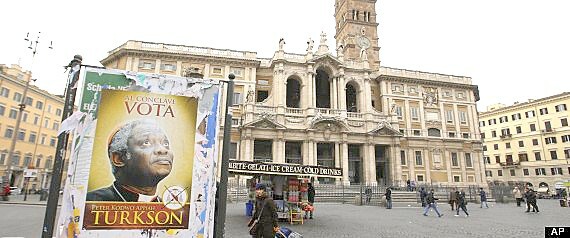
Cardinal Turkson recommended for pope on a banner in front of S. Maria Maggiore
The media, as usual, were full of reports of the viability of this candidate or that candidate. Papabili were everywhere. “I expect the first vote is going to be quite scattered around,” said Cardinal Wilfrid Fox Napier of South Africa, given “the wider field of candidates with the potential” to become pope. [Daniel J. Wakin, in the New York Times, on March 11, 2013] If a South-American were wanted, there was Odilio Scherer (aged 63), Archbishop of Sao Paolo; if a North-American, then one could choose between the Canadian Marc Ouellet, Timothy Dolan of New York or Sean O'Malley (aged 68) of Boston; among the Italians, Angelo Scola was touted as the man in the tradition of Benedict XVI and Cardinal Bertone, and Giovanni Ravasi (aged 70) of the pontifical council on Culture, a curialist, as a learned alternative; if a non-Italian European were wanted, Christoph Schönborn (aged 68) of Vienna was available. Some few, who needed an Asian to promote for the sake of continental symmetry, settled on Luis Tagle of Manila (aged 55), who had only been a cardinal for three months —a very long shot indeed. The most unusual candidate, the African possibility, was Peter Turkson (aged 64), the President of the pontifical council Justitia et Pax. His friends (or was it his enemies?) gigantically overstepped the boundaries of papal pratticà by erecting several large signs in prominent places in Rome, recommending him as a papal candidate. Whatever his merits, his chances of becoming pope instantly sank to zero. Naturally, Tarcisio Bertone, the Secretary of State, was mentioned as papabile, though usually immediately dismissed. A list of all of the 117 electors is given by Salvador Miranda on his Cardinals website. Two eligible electors did not attend, Julius Darmaatmadja of Jakarta, who was ill, and Keith O'Brien of Edinburgh-St. Andrews, who had recently been unmasked as a seminarian sex abuser (by three priests and a former priest). In May, 2013, it was announced that O'Brien would be leaving Scotland at the request of the Holy See: “His Eminence Cardinal Keith Patrick O’Brien, Archbishop Emeritus of St. Andrews and Edinburgh, for the same reasons he decided not to participate in the last Conclave and in agreement with the Holy Father, will be leaving Scotland for several months for the purpose of spiritual renewal, prayer and penance.” On March 20, 2015, the Vatican announced that Cardinal O'Brien had tendered his resignation of all the rights and duties of a cardinal, except the title. This resignation included the right to participate and vote in any future Conclave. Ninety cardinals were above the age of 80 and therefore ineligible to attend the Conclave of March 2013 itself or to vote.
At the First General Congregation of Cardinals, held on March 4, the following oath was required and sworn by each cardinal, in accordance with Pope John Paul II's Universi Dominici Gregis §13:
We, the Cardinals of Holy Roman Church, of the Order of Bishops, of Priests and of Deacons, promise, pledge and swear, as a body and individually, to observe exactly and faithfully all the norms contained in the Apostolic Constitution Universi Dominici Gregis of the Supreme Pontiff John Paul II, and to maintain rigorous secrecy with regard to all matters in any way related to the election of the Roman Pontiff or those which, by their very nature, during the vacancy of the Apostolic See, call for the same secrecy.
It was in the Congregation of March 9 that Cardinal Bergoglio made a particularly important speech to his fellow cardinals. His remarks in Congregation, have been made public, with permission, by Cardinal Ortega of Havana on March 27, 2013. In them Cardinal Bergoglio spoke of a "spiritual worldliness", which, in his view, as the worst evil facing the Church, seriously impeding the ability of the church to engage in evangelization. It is claimed that the impression created by these remarks began to turn the serious attention of many cardinals in the direction of Cardinal Bergoglio [Sandro Magister, "The Last Words of Bergoglio before the Conclave," L' Espresso March 29, 2013; tr, Matthew Sherry].
Reference has been made to evangelization. This is the Church's reason for being. “The sweet and comforting joy of evangelizing” (Paul VI). It is Jesus Christ himself who, from within, impels us.
1) Evangelizing implies apostolic zeal. Evangelizing presupposes in the Church the “parresia” of coming out from itself. The Church is called to come out from itself and to go to the peripheries, not only geographical, but also existential: those of the mystery of sin, of suffering, of injustice, those of ignorance and of the absence of faith, those of thought, those of every form of misery.
2) When the Church does not come out from itself to evangelize it becomes self-referential and gets sick (one thinks of the woman hunched over upon herself in the Gospel). The evils that, in the passing of time, afflict the ecclesiastical institutions have a root in self-referentiality, in a sort of theological narcissism. In Revelation, Jesus says that he is standing at the threshold and calling. Evidently the text refers to the fact that he stands outside the door and knocks to enter. . . But at times I think that Jesus may be knocking from the inside, that we may let him out. The self-referential Church presumes to keep Jesus Christ within itself and not let him out.
3) The Church, when it is self-referential, without realizing it thinks that it has its own light; it stops being the “mysterium lunae” and gives rise to that evil which is so grave, that of spiritual worldliness (according to De Lubac, the worst evil into which the Church can fall): that of living to give glory to one another. To simplify, there are two images of the Church: the evangelizing Church that goes out from itself; that of the “Dei Verbum religiose audiens et fidenter proclamans” [the Church that devoutly listens to and faithfully proclaims the Word of God - editor's note], or the worldly Church that lives in itself, of itself, for itself. This should illuminate the possible changes and reforms to be realized for the salvation of souls.
4) Thinking of the next Pope: a man who, through the contemplation of Jesus Christ and the adoration of Jesus Christ, may help the Church to go out from itself toward the existential peripheries, that may help it to be the fecund mother who lives “by the sweet and comforting joy of evangelizing.”
In an interview, published in the Italian newspaper La Stampa on April 23, 2013 (Gerard O'Connell, “Cardinal Pell: "We've got a Pope who's got mud on his boots"”, La stampa, Vatican Insider, April 23 2013, retrieved May 2, 2013), the Australian Cardinal, George Pell is quoted as having said:
[Interviewer:] Bergoglio gave a short but forceful speech in the General Congregations before the conclave. The Cardinal of Havana has published the full text. Did it really have such a big impact as people say?
[Pell] Yes, obviously it did because he was elected as pope.
[Intevfiewer] Did you see that as a key moment?
[Pell] Yes, it was a significant moment. But there were a lot of good speeches in the General Congregations. Indeed, I thought the General Congregations this time round were better than at the previous conclave; they were very useful.
The good cardinal attempts to argue from consequences toward antecedents (which is of doubtful logical propriety), but nevertheless his testimony as to the importance of the speech for the Election has some value. And apparently the idea of Evangelization had more of an impression upon the minds of the electors than any discussion of pedophile priests, married priests, the decline in vocations, the Vatican Bank, sharing of authority with the Bishops, the place of women in the Church, or other major issues. That the new pope has moved on curial reform and reform of the Vatican Bank in the first months of his reign indicates that he, at least, is aware of the urgency of the situation in these areas.
Conclave
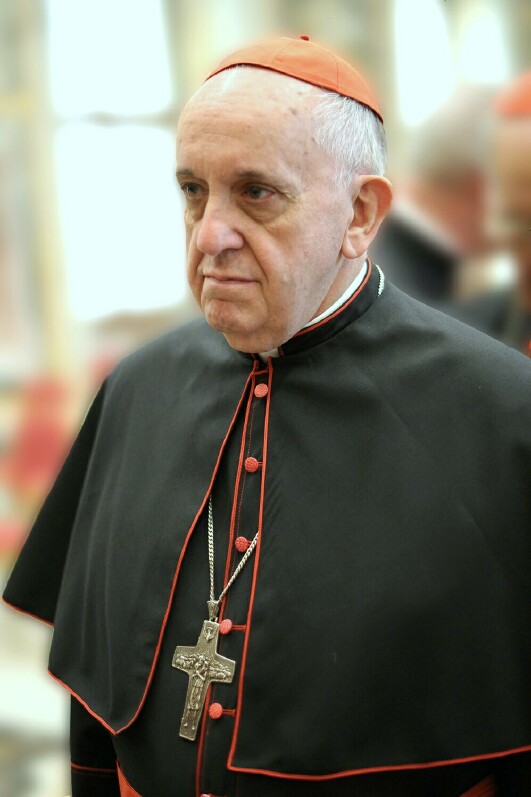 The Conclave of 2013, which began on March 12, was a notably short one, lasting (like the Conclave of 2005) only two days. A successful election, it seems, required five ballots. There were 115 electors, which mean that 77 votes were needed for election.
The Conclave of 2013, which began on March 12, was a notably short one, lasting (like the Conclave of 2005) only two days. A successful election, it seems, required five ballots. There were 115 electors, which mean that 77 votes were needed for election.
Cardinal Roger Mahony (retired Archbishop of Los Angeles, CA) wrote in his blog on March 14, 2013, the day after the Election:
When I entered the Conclave, and our first ballot took place, I was thinking of three possible candidates. However, when I opened the small ballot to place a name there, no hesitation. It felt as if I were not writing the name, but that some power had taken my pen in hand and was doing the writing for me. Within seconds the name was on the first and the subsequent ballots.
It is possible that Cardinal Mahony had the explicit permission of Pope Francis to divulge this information. If not, he may be in violation of his solemn conclave oath taken in the Sistine Chapel before the Cardinals, and the world on television (See Pope John Paul II's Universi Dominici Gregis §§ 58-60). It is also possible that the Cardinal is being disingenuous; he had voted consistently for Bergoglio in the Conclave of 2005. This blog entry may just be his way of saying that he didn't have to think about it, but just voted for Bergoglio again in 2013.
Pope Francis later stated in a public address (to the Media, March 16, 2013) that in the earlier stages of voting he had been encouraged by Cardinal Claudio Hummes of Saõ Paolo, Brazil. Also, when he had been elected, and was being congratulated, Cardinal Hummes whispered to him to remember the poor.
Some people wanted to know why the Bishop of Rome wished to be called Francis. Some thought of Francis Xavier, Francis De Sales, and also Francis of Assisi. I will tell you the story. During the election, I was seated next to the Archbishop Emeritus of São Paolo and Prefect Emeritus of the Congregation for the Clergy, Cardinal Claudio Hummes: a good friend, a good friend! When things were looking dangerous, he encouraged me. And when the votes reached two thirds, there was the usual applause, because the Pope had been elected. And he gave me a hug and a kiss, and said: “Don't forget the poor!” And those words came to me: the poor, the poor. Then, right away, thinking of the poor, I thought of Francis of Assisi. Then I thought of all the wars, as the votes were still being counted, till the end. Francis is also the man of peace. That is how the name came into my heart: Francis of Assisi. For me, he is the man of poverty, the man of peace, the man who loves and protects creation; these days we do not have a very good relationship with creation, do we? He is the man who gives us this spirit of peace, the poor man … How I would like a Church which is poor and for the poor! Afterwards, people were joking with me. “But you should call yourself Hadrian, because Hadrian VI was the reformer, we need a reform…” And someone else said to me: “No, no: your name should be Clement”. “But why?” “Clement XV: thus you pay back Clement XIV who suppressed the Society of Jesus!” These were jokes.
In an interview on September 24, 2013, given to the journalist Eugenio Scalfara of the newspaper La Repubblica (which was published on October 1), Pope Francis recalled his feelings just after his election:
“Before the acceptance, I asked to be able to retire for some minutes in the room next to that with the balcony on the square. My head was completely empty and a great anxiety invaded me,” he said.
“To make it pass and to relax, I close my eyes and every thought disappeared, also that of refusing to accept the charge, as after all the liturgical procedure consents.”
Pope Francis shared that once he closed his eyes, he did not feel anymore “anxiety or emotion,” but that at “a certain point a great light invaded me, it lasted for a second but it seemed really long.”
“Then the light dissipated and I stood straight up and headed to the room where the cardinals were waiting for me and the table on which rested the act of acceptance. I signed it...and then on the balcony came the 'Habemus Papam.'”
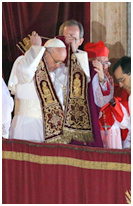 The scoffers immediately began to attribute the "experience" to the sudden release of tension after the Election, to a sudden change in blood pressure, to an adrenalin rush, to the release of endorphins, etc.
The scoffers immediately began to attribute the "experience" to the sudden release of tension after the Election, to a sudden change in blood pressure, to an adrenalin rush, to the release of endorphins, etc.
It was already dark in St. Peter's square on the evening of March 13 when the white smoke coming from the chimney of the Sistine Chapel announced the election of a new pope. In due course, at 7:06 pm, the news was proclaimed from the central balcony of the Loggia of St. Peter's Basilica by the Cardinal Protodeacon, Jean-Louis Tauran. He was followed an hour later, at 8:12 pm, by the new pope and Msgr. Marini, the ceremoniere. In a departure from tradition, the pope was wearing neither the ermine trimmed red velvet mozzetta nor the elaborately decorated stole. His pectoral cross was the simple one which he had been wearing earlier as a cardinal. Msgr. Marini looked distinctly unhappy as he carried the stole in his hands, and had to help the pope put it on when he was ready to give his blessing Urbi et Orbi.
Installation
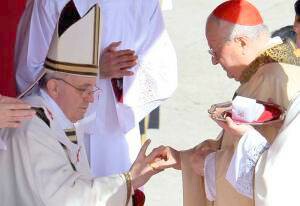 The Mass for the Inauguration of his Petrine Ministry took place in the Piazza S. Pietro on Tuesday, March 19, 2013, the Feast of St. Joseph. All of the cardinals concelebrated the Mass with Pope Francis. The pallium was presented to the new Bishop of Rome by the Cardinal Protodeacon, Jean-Louis Tauran. The Fisherman's ring was presented by Cardinal Angelo Sodano, Bishop of Ostia. The ring was not a new one, but rather an old one which had once belonged to Msgr. Pasquale Macchi, the papal secretary of Paul VI, John Paul I, and John Paul II.
The Mass for the Inauguration of his Petrine Ministry took place in the Piazza S. Pietro on Tuesday, March 19, 2013, the Feast of St. Joseph. All of the cardinals concelebrated the Mass with Pope Francis. The pallium was presented to the new Bishop of Rome by the Cardinal Protodeacon, Jean-Louis Tauran. The Fisherman's ring was presented by Cardinal Angelo Sodano, Bishop of Ostia. The ring was not a new one, but rather an old one which had once belonged to Msgr. Pasquale Macchi, the papal secretary of Paul VI, John Paul I, and John Paul II.
The new pope took up his residence in two rooms in the Domus Sanctae Marthae, and has thus far refused to occupy the papal apartments in the Vatican Palace. He himself has stated that he is doing so lest he become isolated in the papal apartments.
Enthronement as Bishop of Rome
Pope Francis took formal possession of his episcopal throne in the basilica of S. Giovanni Laterano on Sunday, April 7, 2013. Cardinal Vicar, Agostino Vallini, Emeritus Vicar, Cardinal Camillo Ruini, the Bishops' Council of the Diocese and the Council of Parish Prefects co-celebrated the Mass
Priest and students from the city's Major and Minor Seminaries also participated. These included the Redemptoris Mater, the Almo Collegio Capranica and the Oblates of the Oblates of Our Lady of Divine Love Members of the Pontifical Chapel were also present, in accordance with the Motu Proprio “Pontificalis Domus”.
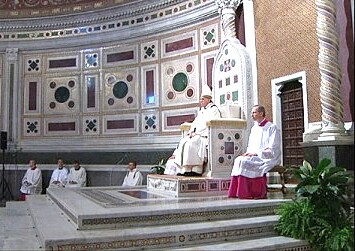 The Pope was enthroned at a ceremony which took place before the start of Mass.
The Pope was enthroned at a ceremony which took place before the start of Mass.
After the enthronement, some Diocese representatives pledged obedience and filial devotion to Pope Francis on behalf of the Church of Rome. Representatives included: Cardinal Vicar Agostino Vallini; Mgr. Filippo Iannone; Vicar to the Capitulate, Mgr. Luca Brandolini; Mgr. Pasquale Silla, parish priest of Santa Maria del Divino Amore in Rome's Castel di Leva area (Dean of parish priests); Fr. Daniele Natalizi, parish vicar of Santa Maria Assunta and San Michele in Rome's Castel Romano area (the youngest in terms of ordination and age, he was ordained in 2012); Fr. Gianpaolo Pertici, Permanent Dean of the Nativita' di Nostro Signore Gesù Cristo Parish, in the Appio Latino district; Fr. Marco Bellachioma, a member of the Franciscan Order of Friars Minor Conventual and diocesan secretary of the Italian Conference of Major Superiors (CISM); Sister Maria Giuseppina Abruzzini, a Salesian nun and diocesan secretary of the Union of Italian Major Superiors (USMI); Marco and Monica Curzi's family with their four children: Francesco (11), Marta (10), Alessandro (9) and Paolo (6); Sofia Presciutti and Massimo Presti from the Diocese of Rome's young people's pastoral service.
Reform Study Group
On April 13, 2013, precisely one month after the election of Pope Francis, the Vatican Secretariat of State announced that the Pope had created "un gruppo di Cardinali per consigliar [il Papa] nel governo della Chiesa universale e per studiare un progetto di revisione della Costituzione Apostolica Pastor Bonus sulla Curia Romana." The announcement said that the Pope was taking a suggestion that emerged during the General Congregations preceding the Conclave (rpirendendo un suggerimento emerso nel corso delle Congregazaioni Generali precedenti il Conclave). This disingenuous remark ignores the quarter of a century or more of complaints from every quarter, inside and outside the Church, that the Roman Curia was in desperate need of reform. The need for reform had been discussed in the newspapers and on television ever since the announcement of Benedict XVI's resignation on February 11, 2013, It was one of the major failures of John Paul II that his Constitution Pastor Bonus did not address the major problems that afflicted and still afflict the central government of the Catholic Church. The idea of curial reform most certainly did not originate in the mind of one of the cardinals during a pre-Conclave consistory, nor did it "emerge" during the General Congregations as a topic needing urgent attention.
The prelates (no laypersons or females were included—in itself a problem of Church government) who were appointed by the Pope were:
- Cardinal Giuseppe Bertello (aged 70), President of the Governorate of Vatican City State
- Cardinal Francisco Javier Errázuriz Ossa (aged 79), Archbishop Emeritus of Santiago de Chile
- Cardinal Oswald Gracias (aged 68), Archbishop of Bombay
- Cardinal Reinhard Marx (aged 59), Archbishop of Munich and Freising
- Cardinal Laurent Monsengwo Pasinya (aged 73), Archbishop of Kinshasa, Democratic Republic of Congo
- Cardinal Sean Patrick O'Malley O.F.M. Cap. (aged 68), Archbishop of Boston
- Cardinal George Pell (aged 71), Archbishop of Sydney
- Cardinal Oscar Andrés Rodríguez Maradiaga, S.D.B. (aged 70), Archbishop of Tegucigalpa, in the role of Coordinator
- Bishop Marcello Semeraro (aged 65), Bishop of Albano, Italy, in the role of Secretary.
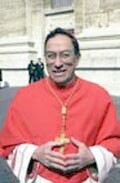 Cardinal Rodriguez, who is a member of the same religious order as Cardinal Tarcisio Bertone, is particularly highly thought of by the Pope. It is possible that he was the recipient of Cardinal Bergoglio's vote at the Election of 2005. His title of Coordinator, however, is an indication that the group is not a legislative or administrative body. It is merely an advisory group, with no authority of its own. The urgency of its task is indicated by the fact that it's first meeting was scheduled for October 1-3, 2013, six months from its creation. By that time, no doubt, the organs of the Curia will have prepared working papers of every sort to indicate exactly how much and what sort of 'reform' it will tolerate.
Cardinal Rodriguez, who is a member of the same religious order as Cardinal Tarcisio Bertone, is particularly highly thought of by the Pope. It is possible that he was the recipient of Cardinal Bergoglio's vote at the Election of 2005. His title of Coordinator, however, is an indication that the group is not a legislative or administrative body. It is merely an advisory group, with no authority of its own. The urgency of its task is indicated by the fact that it's first meeting was scheduled for October 1-3, 2013, six months from its creation. By that time, no doubt, the organs of the Curia will have prepared working papers of every sort to indicate exactly how much and what sort of 'reform' it will tolerate.
In an audience held at the Vatican for the Confederación Latinoamericana y Caribeña de Religiosas y Religiosos (CLAR), on June 6, 2013, Pope Francis made a number of impromptu remarks. These were redacted by the six participants in the audience, and the summary was published on the liberal website Reflexión y Liberación. They subsequently apologized, in a document posted on their website on June 11, 2013. In part their report of the Pope's remarks reads:
This report confirms that the reform of the Curia was one of the topics discussed during the Congregations preceding the Conclave of 2013. One of the major concerns is the existence of a 'gay lobby' in the Curia, a fact which was reportedly uncovered by the three cardinals appointed by Pope Benedict XVI to investigate the "Vatican Leaks", and other complaints about the Curia; their findings were presented to Benedict XVI, but he had not acted on them by the time of his resignation. The Cardinals on the "commission", led by Cardinal Rodríguez Maradiaga [it is unclear whether it is Pope Francis' vocabulary choice, or that of the redactors; according to the leadership of CLAR: "Es claro que sobre esta base no se pueden atribuir al Santo Padre, con seguridad, las expresiones singulares contenidas en el texto, sino solo su sentido general."], will address the issues, assisted by the expertise of Cardinals Francisco Errázuriz and Reinhard Marx. It is clear that the 'Reform Study Group' is meant by the word "commission".
Likewise on June 13, 2013, the Filipino Cardinal Luis Tagle was reported to have made a number of comments on Curial reform to the Corriere della Sera writer Gian Guido Vecchi. His remarks seem to suggest that Pope Francis is thinking far more in terms of a spiritual reform than a cleaning of house. And in La Stampa on June 16, 2013, Giacomo Galeazzi quotes Tagle as saying: “The Curia is in need of purification and reform. Every Curia needs purification in order to guarantee the truth.” He was also asked about a reform of the Vatican Bank. “Possibly, after all, Ecclesia Semper Reformanda Est,” the cardinal replied.
No mention, however, has been made of the sinful cavortings of heterosexual members of the Curia Romana, including solicitation for prostitution and the keeping of mistresses, or the possibility of a 'straight lobby'. It seems that, as with the pedophile priest problem, homosexuality will be made the scapegoat for other and very different problems. The Vatican spokesman, the Rev. Federico Lombardi, refused comment on the CLAR document on June 11, 2013, according to a report in the Washington Post. Lombardi's record for sticking to the truth, it must be said, is not impressive. Opacity, not transparency, is apparently his goal.
On June 13, 2013, Sandro Magister published in L' espresso (no. 24 of 2013; retrieved 06/14/13) the news that Cardinal Reinhard Marx has recommended to the Vatican the services of Thomas von Mitschke-Collande, a German who was the manager of the Munich branch of the McKinsey business consulting firm and is the author of a book, Does the Church want to destroy itself? Facts and analyses presented by a business consultant (Schafft sich die katholische Kirche ab?. Analysen und Fakten eines Unternehmensberaters - Mit einem Vorwort von Kardinal Karl Lehmann) (Random House 2012). Presumably he (and others) will act as periti for the Gruppo di cardinali.
Vatican Bank (IOR) Reform Commission
Also in June, Pope Francis moved to deal with the scandal of the Vatican Bank, which goes back to the reign of Pius XII and his nephews, and includes: the Banco Ambrosiano scandal (IOR was a major shareholder in the Banco Ambrosiano, an Italian bank which collapsed in 1982 with losses of more than $3 billion. Its chairman, Roberto Calvi, was found hanging from Blackfriars Bridge in London - in a murder disguised as a suicide. Calvi had close relations with the Vatican); the "crak Sindona" (which is said to have cost the Vatican more than US$ 250,000,000); the case of Archbishop Paul Marcinkus (whom the Italian Government sought to extradite to face criminal charges); and the money laundering in aid of Polish Solidarity.
On June 15, 2013, the Pope appointed Monsignor Battista Mario Salvatore Ricca as the bank's interim prelate—effectively his representative at the institution. On June 26, 2013, Pope Francis created a new commission, tasked with ensuring the bank operates in "harmony" with the mission of the Church. It is made up of four senior Curia clerics: Italian cardinal Raffaele Farina SDB (aged 79, retired Archivist and Librarian of the Holy Roman Church, of the same religious order as Secretary of State Bertone), French cardinal Jean-Louis Tauran (aged 70, President of the Pontifical Council for Interreligious Dialogue), Spanish titiular-bishop Juan Ignacio Arrieta Ochoa de Chinchetru (aged 62, a priest of Opus Dei and Secretary of the Pontifical Council for Legislative Texts), and Diocese of Omaha Monsignor Peter Bryan Wells (aged 50, Assessor for Archbishop Giovanni Angelo Becciu, who is a deputy of Cardinal Bertone in Section 1 of the Secretariat of State), and a laywoman, Mary Ann Glendon (aged 74, former US Ambassador to the Holy See and currently President of the Pontifical Academy of Social Sciences, and a Harvard law professor).
On June 28, 2013, a senior official of the Vatican financial administration, Msgr. Nunzio Scarano, was arrested on charges of money laundering. Monsignor Scarano, 61, worked for years as a senior accountant for a Vatican department known as APSA (Administration of the Patrimony of the Apostolic See). According to the BBC and Reuters, Monsignor Scarano has been under investigation by Italian police for a series of suspicious transactions involving the recycling through the Vatican bank of a series of cheques described as church donations. Vatican spokesman Father Federico Lombardi said Vatican authorities stood ready to cooperate with the Italian investigation, but had so far received no official request. He said the FIA, the Vatican's own financial intelligence authority, was following the case and would take action if necessary. Such is Vatican transparency. The scandal continued to involve more officials. On July 1, 2013, the BBC reported that the Director and Assistant Director of the IOR, Paolo Cipriani and Massimo Tulli, had tendered their resignations, "in the best interest of the institute and the Holy See"' (according to the Vatican announcement).
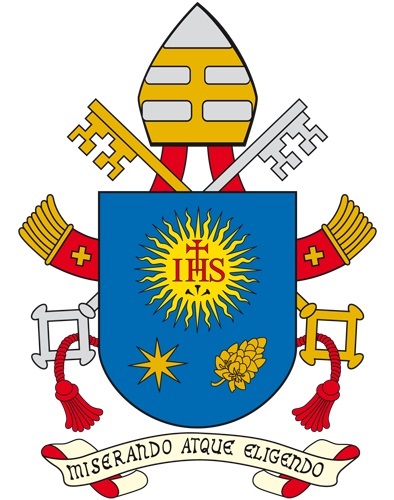
Stemma of Pope Francis
Valerio Gigliotti, La Tiara deposta: La rinuncia al papato nella storia del diritto e della Chiesa. Premessa di Carlo Ossola [Biblioteca della «Rivista di storia e letteratura religiosa» - Studi, vol. 29] (Roma: Olschki 2014).
ISBN: 9788822262981